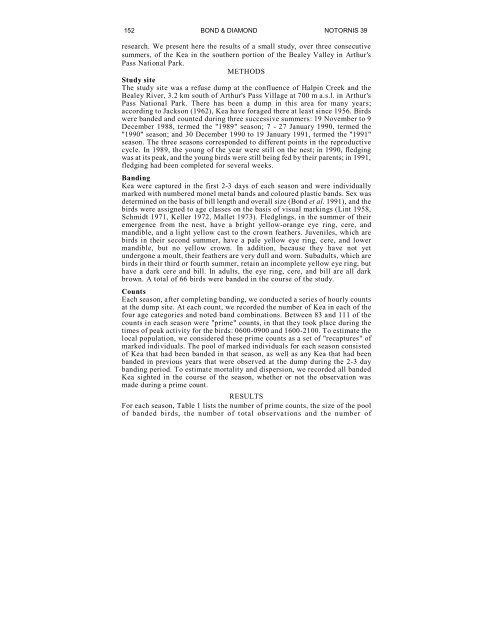NOTORNIS - Kea Conservation Trust
NOTORNIS - Kea Conservation Trust
NOTORNIS - Kea Conservation Trust
Create successful ePaper yourself
Turn your PDF publications into a flip-book with our unique Google optimized e-Paper software.
152 BOND & DIAMOND <strong>NOTORNIS</strong> 39<br />
research. We present here the results of a small study, over three consecutive<br />
summers, of the <strong>Kea</strong> in the southern portion of the Bealey Valley in Arthur's<br />
Pass National Park.<br />
METHODS<br />
Study site<br />
The study site was a refuse dump at the confluence of Halpin Creek and the<br />
Bealey River, 3.2 km south of Arthur's Pass Village at 700 m a.s.l. in Arthur's<br />
Pass National Park. There has been a dump in this area for many years;<br />
according to Jackson (1962), <strong>Kea</strong> have foraged there at least since 1956. Birds<br />
were banded and counted during three successive summers: 19 November to 9<br />
December 1988, termed the "1989" season; 7 - 27 January 1990, termed the<br />
"1990" season; and 30 December 1990 to 19 January 1991, termed the "1991"<br />
season. The three seasons corresponded to different points in the reproductive<br />
cycle. In 1989, the young of the year were still on the nest; in 1990, fledging<br />
was at its peak, and the young birds were still being fed by their parents; in 1991,<br />
fledging had been completed for several weeks.<br />
Banding<br />
<strong>Kea</strong> were captured in the first 2-3 days of each season and were individually<br />
marked with numbered monel metal bands and coloured plastic bands. Sex was<br />
determined on the basis of bill length and overall size (Bond et al. 1991), and the<br />
birds were assigned to age classes on the basis of visual markings (Lint 1958,<br />
Schmidt 1971, Keller 1972, Mallet 1973). Fledglings, in the summer of their<br />
emergence from the nest, have a bright yellow-orange eye ring, cere, and<br />
mandible, and a light yellow cast to the crown feathers. Juveniles, which are<br />
birds in their second summer, have a pale yellow eye ring, cere, and lower<br />
mandible, but no yellow crown. In addition, because they have not yet<br />
undergone a moult, their feathers are very dull and worn. Subadults, which are<br />
birds in their third or fourth summer, retain an incomplete yellow eye ring, but<br />
have a dark cere and bill. In adults, the eye ring, cere, and bill are all dark<br />
brown. A total of 66 birds were banded in the course of the study.<br />
Counts<br />
Each season, after completing banding, we conducted a series of hourly counts<br />
at the dump site. At each count, we recorded the number of <strong>Kea</strong> in each of the<br />
four age categories and noted band combinations. Between 83 and 111 of the<br />
counts in each season were "prime" counts, in that they took place during the<br />
times of peak activity for the birds: 0600-0900 and 1600-2100. To estimate the<br />
local population, we considered these prime counts as a set of "recaptures" of<br />
marked individuals. The pool of marked individuals for each season consisted<br />
of <strong>Kea</strong> that had been banded in that season, as well as any <strong>Kea</strong> that had been<br />
banded in previous years that were observed at the dump during the 2-3 day<br />
banding period. To estimate mortality and dispersion, we recorded all banded<br />
<strong>Kea</strong> sighted in the course of the season, whether or not the observation was<br />
made during a prime count.<br />
RESULTS<br />
For each season, Table 1 lists the number of prime counts, the size of the pool<br />
of banded birds, the number of total observations and the number of












